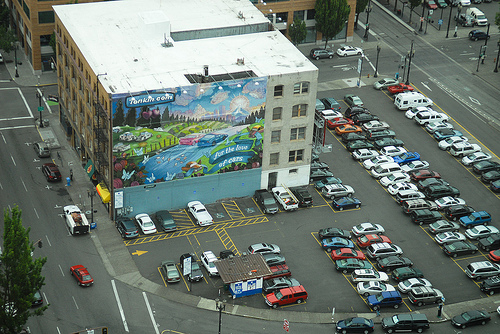It looks like Portland is finally ready to think long-term about its auto parking policies.
The City of Portland is preparing to embark on an 18-month study of its future auto parking needs, thanks to a $225,000 state grant. The result of the work, which the city said seems to be the first project of its kind in the country, could shape residential and commercial development patterns and on-street parking policy in the city for decades to come.
And for people who care about fixing Portland’s chronic shortage of low-car-friendly housing, or who those who want the city to reduce the tax-funded handout of so much free auto parking, the tea leaves look good.
“We, as a City, need to decide what parking access and convenience level we find acceptable given our other city goals (mode split goals, air quality, housing affordability, etc.).”
— City of Portland grant application
The idea of the study is to force the city to ask itself, “Given what we say we want this area to develop into, what will parking look like then?” said Sara Schooley, parking policy analyst for the Portland Bureau of Transportatation.
To that end, the project will study the current auto parking needs of five different “corridors” and five different “centers,” which Schooley said will be scattered throughout the city.
Then Schooley and her colleagues will estimate how much or how little space should be available for parking for the city to develop that area as it wants to — and compile a list of policy options to make that work; such as whether paid parking permits, meters, or better bike, foot and transit access are needed.
“We, as a City, need to decide what parking access and convenience level we find acceptable given our other city goals (mode split goals, air quality, housing affordability, etc.),” the city wrote in its grant application (PDF).
That’s a smart take. It’s true that Portland streets are getting more crowded and annoying to park in. But it’s just as true that in a city where 25 percent of renters already get by without a car, mandatory auto parking rules drive up housing costs and make dense, walkable development illegal.

(Photo by M.Andersen/BikePortland)
Here are some other relevant passages from the city’s grant proposal, emphases mine:
Building parking is an expensive venture and, if built excessively, can burden both the developer and future residents or customers. When parking is built, the costs of building and maintaining the space or garage is passed to the user, thus increasing the costs of rent. This increase in costs can lead to residents and businesses being “priced out” of an area; given the concentration of services in Portland’s centers and corridors, these are exactly the areas where those who are at risk of being “priced out” should be living to increase their access to housing types, services, transit, and community.
“A successful parking environment will not have an oversupply of parking and instead look to create a supply based on actual and future demand.”
— City of Portland
When looking at parking and potentially planning parking requirements and infrastructure for the future, it is important to provide access to transportation options so that residents can live the low‐car lifestyles that the City looks to encourage. The parking policy toolkit will also offer recommendations of how active transportation should complement parking strategies to create access into and out of the centers and corridors, as well as support the economic growth of each center and corridor.
Even while Portland aims to reduce VMT, driving remains the most used form of transportation in the City. Therefore, driving (and its associated parking) is integral to the economic success of the City and region. That said, a successful parking environment will not have an oversupply of parking and instead look to create a supply based on actual and future demand. The aim of this project will be to set guidelines to determine what adequate supply for the future looks like as transportation patterns change.
Like every project of this size, the devil will be in details such as the precise meaning of “adequate.” But reading the way the city has framed its big goals here made me want to start handing out halos.
The Real Estate Beat is a weekly column. Read past installments here. We are looking for a sponsorship partner. If interested, please call Jonathan at (503) 706-8804.



